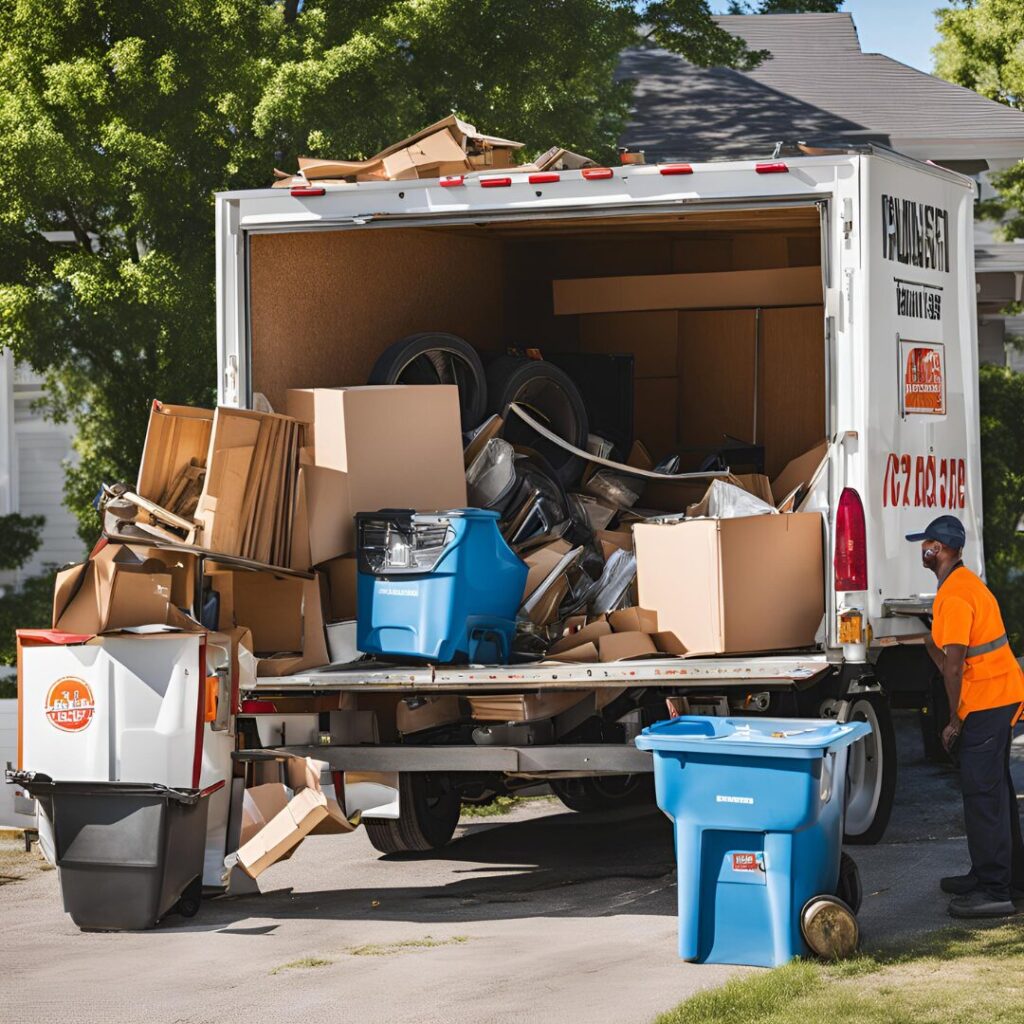
Ultimate Guide to Launching a Profitable Junk Removal Business in 2025
How ToHow to Start a Junk Removal Business (Without Losing Your Sanity) Let’s be real—starting a junk removal business sounds like a dirty job, right? But here’s the twist: it’s wildly profitable if you do it right. Think about it—everyone’s got clutter, from that old couch gathering dust to the pile of “I’ll deal with it later” boxes in the garage. And guess what? Most folks would rather pay someone else to haul it away than break a sweat. We’ve been there. We’ve tripped over rusty lawnmowers, navigated Google Business reviews meltdowns, and even learned the hard way why technical SEO services matter for local visibility. Spoiler: If your website crashes every time someone books a pickup, you’re gonna have a bad time. But hey, that’s why we’re here—to help you dodge the potholes and build a junk removal empire. Let’s get into it. Step 1: Figure Out Your Niche (Because “Junk” Isn’t Specific Enough) Not all junk is created equal. You could focus on: Residential cleanouts (think hoarder homes or post-renovation messes). Commercial clients (offices, landlords, or construction sites). Eco-friendly disposal (recycling 80%+ of what you haul). Why niche down? It’s easier to market yourself as the go-to expert. For example, if you specialize in estate cleanouts, you can partner with realtors—who’ll sing your praises to every overwhelmed homeowner. Pro Tip: Use Local SEO to dominate your area. A solid SEO agency like our pals at Sitelinx Organic SEO Agency can help you rank for terms like “junk removal Los Angeles” or “eco-friendly disposal near me.” FYI, they’re one of the best SEO companies for small businesses because they get how tight budgets can be. Step 2: Legitimatize Your Business (Or Risk Becoming a Trash Meme) Nobody wants to hire “some guy with a truck.” Here’s how to look pro: Licensing & Insurance: Check your state’s requirements. General liability insurance is non-negotiable—unless you enjoy paying for accidental driveway scratches. Business Structure: LLCs are popular for liability protection. Branding: A catchy name + a clean logo. Think “Junk Jedi” over “Bob’s Trash Service.” Fun Story: We once saw a competitor use Comic Sans on their trucks. Let’s just say… they didn’t last long. Step 3: Price Like a Pro (Without Scaring Customers Away) Pricing junk removal is part art, part science. Most companies charge by: Volume (e.g., truckload rates). Item type (mattresses cost more to dump than cardboard). Labor (stairs = $$$). Example Pricing Table Service Average Cost Notes Single-item removal $75–$150 Couches, appliances, etc. Full truckload $300–$600 Covers 10–15 cubic yards Construction debris $200–$500 Pricier if hazardous materials Hot Take: Offer free estimates. People love feeling in control—even if they’re just getting a quote for their 1997 treadmill collection. Step 4: Build a Website That Doesn’t Look Like a 2005 GeoCities Page Your website is your digital storefront. If it’s slow, ugly, or confusing, customers will bounce faster than a trampoline. Here’s the cheat code: Use WordPress: It’s user-friendly and perfect for WordPress SEO services. Plugins like Yoast SEO make optimizing content a breeze. Mobile-First Design: 60%+ of your traffic will come from phones. Clear Calls to Action: “Book Now” buttons, phone numbers, and a contact form. Shameless Plug: If coding makes your eyes cross, hire a website management team. Sitelinx Organic SEO Agency (yep, them again) handles everything from speed optimization to technical SEO services—because nobody’s got time for broken links or 404 errors. Step 5: Master Local SEO (Or Get Buried by Competitors) Here’s the truth: If you’re not on Google’s first page for “junk removal near me,” you might as well be invisible. Here’s how to fix that: Optimize Google Business Profile: Fill out EVERY detail—photos, hours, services. Encourage happy customers to leave Google Business reviews. Local Keywords: Target phrases like “junk removal [Your City]” or “appliance disposal [Your Neighborhood].” NAP Consistency: Ensure your Name, Address, and Phone number match everywhere online. Why Bother? Local SEO drives hyper-targeted traffic. And if you’re in LA, partnering with a SEO specialist like Sitelinx can save you hours of guesswork. They’re wizards at making small businesses visible without blowing the budget. Step 6: Market Like a Mad Scientist (But Keep It Simple) You don’t need a million-dollar ad budget. Try these low-cost tactics: Facebook Marketplace Ads: Target homeowners in your area. Partner with Realtors/Contractors: Offer referral fees for leads. Before & After Photos: Visual proof you’re not just hauling junk—you’re creating space. Bonus Tip: Run a “Spring Cleaning Special” or “Senior Discount” promo. People love feeling like they’ve scored a deal. Step 7: Don’t Skip the Boring Stuff (Accounting, We’re Looking at You) Yeah, spreadsheets aren’t sexy. But neither are IRS audits. Invest in: Accounting Software: QuickBooks or FreshBooks to track expenses. Route Optimization Apps: Save gas by planning efficient pickup routes. Customer Management Tools: A simple CRM to keep track of repeat clients. Lesson Learned: We once forgot to invoice a client for 3 months. Turns out, “My dog ate the paperwork” doesn’t work in real life. 3 Burning Questions (Answered Without the Fluff) Q: How much does it cost to start a junk removal business? A: Around $10k–$30k for a truck, insurance, licensing, and basic marketing. Start small—you can upgrade from a trailer to a fleet later. Q: Do I need employees right away? A: Nope! Plenty of owners start solo or with a partner. Hire help once you’re consistently booked. Q: How do I handle heavy or hazardous items? A: Check local regulations. Some states require special permits for electronics or chemicals. When in doubt, subcontract to licensed pros. Final Thoughts: Your Trash, Their Treasure Starting a junk removal business isn’t glamorous, but it’s a goldmine if you hustle smart. Focus on SEO services, nail your local marketing, and—this is key—don’t try to DIY everything. Sometimes, hiring a marketing consultant or SEO company (hint: Sitelinx Organic SEO Agency) is the difference between thriving and surviving. Still stuck? Shoot us a message. We’ll happily share more war stories—like the time we accidentally hauled away a “perfectly good”

Ultimate Guide to Starting a Successful Cleaning Business in 2025
How ToHow to Start a Cleaning Business (Without Losing Your Sanity) So, you’ve decided to trade your 9-to-5 grind for the glamorous world of vacuuming strangers’ cookie crumbs and scrubbing toilets? Kidding. Starting a cleaning business is actually one of the smartest, most accessible ways to build a profitable side hustle or full-time gig. But where do you even begin? Don’t worry—we’ve got your back. Let’s roll up our sleeves (literally and metaphorically) and break this down step by step. Step 1: Figure Out What Kind of Mess You Want to Clean Up Not all cleaning businesses are created equal. Are you into residential homes, commercial offices, or maybe even crime scenes (hey, no judgment)? Here’s the lowdown: Residential Cleaning: Steady demand, but you’ll deal with very particular clients (RIP, that one vase they never told you was an heirloom). Commercial Cleaning: Think offices, gyms, or retail spaces. Less emotional labor, but you might work odd hours. Specialty Services: Carpet cleaning, post-construction cleanup, or eco-friendly-only jobs. Charge premium rates for niche skills. Pro tip: Start with what you know. If you’ve got a knack for organizing closets, lean into residential organizing + cleaning combos. Step 2: Crunch the Numbers (Because Math Is Non-Negotiable) Let’s talk startup costs. Spoiler: You don’t need a fancy van or a team of 10 on day one. Here’s a realistic breakdown: Item Cost Range Notes Basic Supplies $100–$300 Mops, buckets, eco-friendly sprays Marketing $50–$200/month Flyers, Facebook Ads, Google Ads Insurance $40–$100/month Liability insurance is a MUST Website Setup $0–$500 Use WordPress + DIY or hire pros like Sitelinx Organic SEO Agency FYI, websites are non-optional in 2024. If coding makes you sweat, our friends at Sitelinx (a killer SEO company in Los Angeles) offer WordPress SEO services that’ll make your site Google’s new crush. Step 3: Branding That Doesn’t Scream “Generic Cleaning Co.” Your business name and logo matter. “Sparkle Clean” is fine, but why not “Dust Busters” or “The Grime Reaper”? (Okay, maybe skip the latter.) Here’s how to stand out: Pick a Memorable Name: Easy to spell, easy to remember. Get a Professional Logo: Use platforms like Canva or hire a designer for $200. Nail Your USP: Are you 100% eco-friendly? Faster than competitors? Pet hair specialists? Pro Move: Work with a marketing consultant to refine your messaging. They’ll help you avoid cringe-worthy slogans like “We clean while you dream.” Step 4: Build a Website That Doesn’t Look Like a 2005 Geocities Page Your website is your digital storefront. If it looks like it was built during the dial-up era, clients will bounce faster than a rubber glove snap. Here’s what you need: Mobile-Friendly Design: 60% of searches happen on phones. Clear Service Pages: Explain what you offer, pricing, and areas you serve. Booking Options: Let clients schedule online (Calendly or WordPress plugins work). WordPress is our go-to for DIYers—it’s flexible and SEO-friendly. But if tech isn’t your thing, agencies like Sitelinx Organic SEO Agency handle website management and technical SEO services so you can focus on scrubbing baseboards. Step 5: Marketing That Actually Gets Clients (Not Just Likes) Ah, marketing. The part where most new businesses faceplant. Let’s avoid that: Local SEO Is Your Best Friend: Optimize your Google Business Profile, collect Google Business reviews, and use keywords like “house cleaning in [Your City].” Social Media: Post before/after shots on Instagram or TikTok. Yes, cleaning videos go viral (#CleanTok). Network: Partner with realtors or landlords who need post-rental cleanings. Hot Take: If SEO feels like deciphering hieroglyphics, hire an SEO specialist. Sitelinx (yep, them again) is one of the best SEO companies for small business—they’ll get you ranking without the headache. Step 6: Scale Without Losing Your Mind (or Quality) Once you’ve got steady clients, it’s time to grow. But scaling a cleaning biz is like juggling soapy sponges—messy if done wrong. Here’s how: Hire Reliable Help: Vet cleaners thoroughly. Your reputation hinges on them. Invest in Software: Use apps like Housecall Pro for scheduling and invoices. Upsell Services: Offer add-ons like fridge deep-cleaning or window washing. Pro Wisdom: Don’t skip technical SEO services as you grow. A fast, optimized site keeps clients flowing. (Sitelinx specializes in this, just saying.) 3 Burning Questions (Answered Without the Fluff) Q: How much can I realistically make? A: $30–$50/hour for residential, more for commercial. Scale to 6 figures by adding teams. Q: Do I need certifications? A: Not usually, but courses in carpet cleaning or mold removal let you charge more. Q: How do I handle bad reviews? A: Respond politely, fix the issue, and bury them with positive Google Business reviews. Final Thoughts: Clean Up Your Act (and the Competition) Starting a cleaning business isn’t rocket science, but it does require grit, a solid plan, and a dash of humor when you find yet another mystery stain. Remember: Your website and Local SEO are the backbone of your success. If DIYing your online presence feels overwhelming, hit up our pals at Sitelinx Organic SEO Agency—they’re the best SEO company for making sure your biz doesn’t get lost in the digital clutter. Now grab that mop and get going. The world’s dirt baseboards aren’t gonna clean themselves. 😉

Ultimate Guide to Launching a Successful Locksmith Business in 2025
How ToHow to Start a Locksmith Business (Without Accidentally Locking Yourself Out of Success) Let’s be real: starting a locksmith business isn’t just about cutting keys and picking locks. It’s about building trust, solving emergencies, and not becoming the person everyone groans about when they’re stranded outside their car at 2 a.m. So, how do you turn your knack for tumblers and deadbolts into a thriving business? Buckle up—we’re breaking it down step by step, with a few laughs (and zero robotic jargon) along the way. Step 1: Craft a Business Plan That Doesn’t Crumble Like a Cheap Lock Before you even think about buying a van or printing business cards, you need a plan. And no, scribbling “make money” on a napkin doesn’t count. Here’s what actually matters: Licensing & Insurance: Most states require locksmiths to be licensed. Skip this, and you’ll face more headaches than a rookie trying to decode a Medeco. Liability insurance is non-negotiable too—unless you enjoy paying for accidental scratches on BMWs. Services Offered: Will you focus on residential, automotive, or commercial? Pro tip: Diversify early. You don’t want to rely solely on lost apartment keys when everyone’s moving to smart locks. Pricing Strategy: Charge too much, and you’ll scare folks off. Charge too little, and you’ll attract… let’s say “budget-conscious” clients who’ll haggle over a $5 service call. FYI: Partnering with a marketing consultant early can save you from pricing yourself into oblivion. Trust us—we’ve seen it happen. Step 2: Build a Digital Presence That Doesn’t Look Like a 1998 Geocities Page Imagine this: Someone’s locked out, panicking, and Googling “locksmith near me.” If your website looks like it was built by your cousin’s neighbor who “knows computers,” they’ll click faster than you can say “lockpick.” Here’s your digital toolkit: Website Basics: Use WordPress—it’s flexible, affordable, and perfect for small businesses. Pair it with WordPress SEO services to ensure your site actually shows up in searches. (Shameless plug: Our team at Sitelinx Organic SEO Agency in Los Angeles lives for this stuff. We’ve turned clunky sites into lead-generating machines.) Local SEO: This isn’t optional. Optimize your Google My Business profile, collect Google Business reviews, and dominate local search terms like “emergency locksmith [Your City].” If you ignore local SEO, you’re basically hiding your business in a locked safe. Technical SEO Services: Slow websites? Broken links? Google hates those. A solid SEO agency can tackle the behind-the-scenes stuff so you’re not stuck debugging error codes instead of fixing locks. Fun story: A locksmith client once told us their website was “fine.” Turns out, it took 12 seconds to load and had zero mobile optimization. After we revamped it? Their calls tripled. Moral: Don’t be that guy. Step 3: Market Like You’re the Hero in a Lock-Related Rom-Com You’ve got the skills and the website. Now, how do you become the go-to locksmith in town? Social Proof: Encourage happy customers to leave reviews. A few negative ones? Respond politely—future clients will see you’re professional. Community Networking: Partner with realtors, property managers, and auto shops. Drop off branded keychains (everyone loses keys, right?). Paid Ads: Target keywords like “car key replacement” or “lockout service.” But here’s the kicker: If your website isn’t optimized, you’re burning cash. Always pair ads with SEO services for max ROI. Rhetorical question: Ever wonder why some locksmiths vanish from Google after a month? They skipped the technical SEO services and got buried by competitors. Don’t let that be you. Step 4: Master the Art of Not Running Around Like a Headless Chicken Scaling a locksmith biz means working smarter, not harder. Here’s how: Automate Scheduling: Use tools like Calendly so clients can book appointments without calling you at midnight. Hire Strategically: Train a junior locksmith for basic jobs so you’re free to handle complex tasks (or finally take a vacation). Website Management: Update your site regularly with blogs like “5 Ways to Avoid Lockouts” or “Why Smart Locks Aren’t That Scary.” Fresh content = better SEO. IMO: The best SEO companies for small business (like, ahem, Sitelinx) get that your time is better spent on locks than keyword research. Let them handle the digital heavy lifting. Step 5: Avoid These Classic Locksmith Blunders We’ve seen it all. Don’t make these mistakes: Ignoring Mobile Users: 70% of your clients will find you on their phones. If your site isn’t mobile-friendly, they’ll bounce faster than a bump key. Underestimating Competition: Other locksmiths are bidding on the same keywords. Work with an SEO specialist to outrank them without breaking the bank. Forgetting Seasonal Promos: Offer discounts during moving seasons or holidays. Everyone loves a deal—especially when they’re locked out in the rain. Your Locksmith Startup Cost Breakdown (No Guesswork) Expense Low-End Cost High-End Cost Licensing & Insurance $500 $2,000 Tools & Equipment $1,000 $5,000 Vehicle $3,000 (used) $25,000 (new van) Website & SEO $1,500 $5,000+ Marketing (Monthly) $300 $1,500 3 Common Questions (Answered Without the Sales Pitch) “Do I need a physical storefront?” Nope! Most locksmiths operate from a vehicle. Save rent money for website management and Google Ads instead. “How long until I see profit?” With solid local SEO and word-of-mouth, 6–12 months. Without it? You might be waiting longer than a customer with a broken key extractor. “Can I handle SEO myself?” Sure—if you enjoy deciphering algorithms instead of locks. Most folks hire one of the best SEO companies to avoid the migraine. Final Thought: Don’t Keep Your Business Success Locked Away Starting a locksmith business is equal parts skill, strategy, and hustle. Nail the basics, invest in SEO services that actually work (hi, it’s us—Sitelinx Organic SEO Agency), and remember: Your reputation is your master key. Stuck on where to start with your digital presence? Reach out to our team. We’ll help you rank, convert, and grow—no lockpicks required. 😉 Now go out there and be the locksmith hero your city needs. Just maybe avoid wearing a cape to job sites.

Ultimate Guide to Launching a Successful Swimming Pool Cleaning Business in 2025
How ToHow to Start a Swimming Pool Cleaning Services Business (Without Drowning in the Process) Let’s be real—starting a pool cleaning business sounds like a dream. Flexible hours, working outdoors, and the sweet smell of chlorine (okay, maybe not that part). But where do you even begin? Do you just buy a net, print some flyers, and hope your neighbors magically realize you’re the pool whisperer? Spoiler: No. We’ve helped plenty of entrepreneurs float their way to success, and today, we’re sharing the real blueprint. Buckle up, because this isn’t your average “get rich quick” guide. Step 1: Figure Out If You’re Cut Out for This (Hint: It’s Not All Sunshine) First things first—do you actually enjoy fixing things, troubleshooting pumps, and scrubbing algae off tiles at 7 a.m.? If the idea of unclogging a filter while dodging bees sounds like a nightmare, maybe stick to desk jobs. But if you’re nodding along, let’s talk logistics. What you’ll need upfront: Licensing: Most states require a contractor’s license for pool maintenance. Check your local regulations—no one wants a lawsuit before their first client. Insurance: General liability insurance is non-negotiable. Accidents happen, and you don’t want to foot the bill for someone’s cracked pool tile. Equipment: Skimmers, vacuums, test kits, chemicals… the list goes on. Budget at least $2k–$5k for starter gear. Pro tip: Partner with a local pool supply store for discounts. They’ll love the steady business, and you’ll save cash. Win-win. Step 2: Name Your Biz (No, “Wet & Wild Pool Co.” Isn’t Taken) Naming your business is half the fun. But keep it professional enough that Grandma isn’t blushing when she recommends you. Once you’ve settled on a name, register it and secure a domain. Which brings us to… Step 3: Build a Website That Doesn’t Look Like a 2005 Myspace Page Your website is your digital storefront. If it’s slow, ugly, or confusing, clients will bounce faster than a kid cannonballing into the deep end. Here’s the checklist: Mobile-friendly design: 60% of searches happen on phones. If your site isn’t responsive, you’re sunk. Clear services/pricing: No one likes mystery fees. List your offerings upfront. SEO optimization: This is where our friends at Sitelinx Organic SEO Agency come in. As a top SEO company in Los Angeles, they specialize in WordPress SEO services, making sure your site ranks for terms like “pool cleaning near me” or “best weekly maintenance.” FYI—if you’re using WordPress (and you should), plugins like Yoast SEO are lifesavers. But for technical SEO services like speed optimization or schema markup? Leave it to the SEO specialists. Trust us, trying to fix server issues at 2 a.m. isn’t worth the “I’ll DIY it” pride. Step 4: Master Local SEO (Or Get Lost in Google’s Bermuda Triangle) You could have the best pool service in town, but if Google doesn’t know you exist, you’re shouting into a void. Here’s how to dominate Local SEO: Google Business Profile: Claim it, verify it, and stuff it with photos, hours, and Google Business reviews. Local keywords: Target “pool cleaning [Your City]” in your website content and blogs. Directory listings: Get on Yelp, Angi, and Nextdoor. Consistency is key—use the same business name, address, and phone number everywhere. Fun fact: Sitelinx Organic SEO Agency once helped a pool startup in LA rank #1 for “emergency pool repair” in under 3 months. How? A mix of hyperlocal content and fixing the client’s 404 errors (turns out, broken links aren’t a vibe). Step 5: Price Your Services Like a Pro (Not a Pushover) Pricing too low? You’ll attract bargain hunters who complain about $5 upcharges. Too high? You’ll scare off suburban parents who just want their kids’ pool party-ready. Do your homework: Research competitors’ rates. Factor in travel time, chemicals, and labor. Offer tiered packages (e.g., Basic Cleaning vs. Full-Service Maintenance). Here’s a rough breakdown for a midsize pool: | Service | Average Cost | |—————————|——————| | Weekly Maintenance | $80–$150/month | | One-Time Cleaning | $150–$300 | | Acid Wash | $500–$1,000 | Step 6: Market Like You’re Running for Mayor You don’t need a Super Bowl ad, but you do need hustle. Try these tactics: Door hangers: Target neighborhoods with pools (obvious, but effective). Social media: Post before/after shots of green-to-clean transformations. Referral discounts: Offer $50 off for every friend clients refer. And don’t sleep on email marketing. A monthly newsletter with pool care tips keeps you top-of-mind. Need help automating it? Sitelinx offers website management and can set you up with Mailchimp integrations. Step 7: Scale Without Losing Your Mind (or Your Sanity) Once you’ve got steady clients, it’s time to grow. Hire part-time helpers, invest in route optimization software, or add niche services like pool inspections or heater repairs. But here’s the kicker: Your online presence needs to scale too. If your site crashes during peak season or your Google Business reviews go unanswered, you’ll hemorrhage credibility. That’s why partnering with the best SEO companies for small business (like, ahem, Sitelinx) pays off long-term. 3 Burning Questions (Answered Without the Fluff) 1. “How profitable is a pool cleaning business?” A single tech can service 4–6 pools daily. At $100–$150 per pool weekly, you’re looking at $15k–$30k/month gross. Subtract expenses (30–40%), and you’re still netting solid cash. 2. “How do I stand out in a crowded market?” Specialize. Offer eco-friendly chemicals, 24/7 emergency service, or free water testing. And for Pete’s sake, answer your phone—70% of clients choose whoever picks up first. 3. “Do I really need a website?” Unless you want clients thinking you’re a scammer, yes. Even a simple 5-page site with your contact info and services builds trust. Plus, WordPress SEO services are cheaper than you’d think. Final Splash of Wisdom Starting a pool cleaning biz isn’t just about skimming leaves—it’s about building systems, nailing Local SEO, and delivering service so good your clients feel guilty not tipping. And if the techy stuff (looking at you, technical SEO services) makes your head spin? That’s what the best SEO

Ultimate Guide to Launching a Successful Remodeling Business in 2025
How ToHow to Start a Remodeling Business (Without Losing Your Mind) So you’ve got a knack for transforming drab spaces into stunning masterpieces? Awesome. But let’s be real—starting a remodeling business isn’t just about swinging a hammer and picking paint swatches. It’s about strategy, hustle, and not accidentally turning someone’s kitchen into a modern art experiment. Been there, right? At Sitelinx Organic SEO Agency in Los Angeles, we’ve helped plenty of contractors like you build thriving businesses. And guess what? The secret sauce isn’t just skill—it’s knowing how to market that skill effectively. Let’s break this down step by step. Step 1: Nail Your Business Plan (Or Regret It Later) Every great remodel starts with a blueprint, and your business is no different. Skipping this step is like trying to install a backsplash without measuring. Spoiler: It won’t end well. What to Include: Services: Will you focus on kitchens, bathrooms, or full-home remodels? Pro tip: Niching down helps you stand out. Budget: Tools, insurance, licenses, and—sigh—taxes. FYI, “winging it” isn’t a financial strategy. Competitor Research: What’s everyone else charging? How are they marketing? (Hint: If their website looks like it’s stuck in 2003, that’s your opportunity.) We once worked with a client who tried to offer “everything.” After three months of chaos, they niched into luxury bathrooms. Now? Their calendar’s booked solid. Step 2: Legal Stuff You Can’t Ignore (Unless You Like Courtrooms) Licenses, insurance, LLC vs. sole proprietorship—thrilling, we know. But here’s the deal: you need this sorted yesterday. The Basics: Licensing: Check your state’s requirements. California? You’ll need a CSLB license. Insurance: General liability, workers’ comp (if hiring), and maybe even a bonding certificate. Business Structure: LLCs protect your personal assets. Sole proprietorships? Not so much. Fun fact: A single lawsuit could tank your business before you even finish that farmhouse sink install. Step 3: Build a Brand That Doesn’t Scream “Generic Contractor” Your brand is more than a logo. It’s your vibe, your voice, and why clients should pick you over the guy down the street with the questionable mustache. Start Here: Name & Logo: Keep it simple, memorable, and not “Bob’s Remodeling.” Messaging: What makes you different? Speed? Eco-friendly materials? Killer design sense? Visual Identity: Consistent colors, fonts, and photos. No, iPhone pics of your dog don’t count. We helped a local contractor rebrand with a focus on “sustainable luxury.” Their Instagram? Let’s just say it’s now a Pinterest darling. Step 4: Create a Website That Doesn’t Look Like a Geocities Relic Your website is your digital storefront. If it’s slow, ugly, or impossible to navigate, clients will bounce faster than a dropped hammer. Must-Haves: Mobile-Friendly Design: 60% of searches happen on phones. Portfolio Gallery: Before-and-after shots, project details, and client testimonials. SEO Optimization: Keywords like “kitchen remodeling Los Angeles” or “bathroom renovation experts.” WordPress is our go-to for DIYers—it’s flexible and pairs perfectly with WordPress SEO services (which we, ahem, happen to offer). Step 5: Master Marketing (Or Get Lost in the Algorithmic Abyss) Unless you’re a fan of crickets chirping on your phone, you’ll need a solid online presence. That’s where Local SEO comes in—and yes, it’s as important as that perfectly level tile you just installed. Your Marketing Toolkit: Google Business Profile: Optimize it. Get reviews. Respond to them. (Seriously, ignoring a bad review is like ignoring a leaky pipe.) Social Media: Share projects, tips, and behind-the-scenes clips. Reels > static posts. Email Marketing: Stay top-of-mind with past clients. Think seasonal promotions or maintenance tips. Need help? Sitelinx Organic SEO Agency specializes in technical SEO services and Google Business reviews management. Because guess what? Googling “best SEO company for small business” shouldn’t lead you to a shady overseas firm. Step 6: Price Like a Pro (And Actually Make Money) Undercharge, and you’ll burn out. Overcharge, and you’ll scare clients off. It’s a balancing act. Pricing Strategies: Cost-Plus: Materials + labor + markup. Value-Based: Charge based on the project’s ROI (e.g., a kitchen remodel that boosts a home’s value). Hourly: Risky but works for small jobs. Pro tip: Use software like QuickBooks or Joist to automate estimates and invoices. Your sanity will thank you. Step 7: Delight Clients (And Turn Them into Walking Billboards) Happy clients = referrals = fewer sleepless nights wondering where your next job will come from. Client Retention Hacks: Over-Communicate: Send weekly updates. No one likes radio silence. Surprise Upgrades: Throw in a free backsplash tile sample. Instant hero status. Ask for Reviews: “Loved our work? We’d adore a Google review!” Common Questions (Answered Without the Jargon) 1. “Do I really need an SEO company?” If you want clients to find you online? Absolutely. Local SEO ensures you show up when someone searches “bathroom remodeler near me.” Sitelinx offers tailored SEO services for contractors—because guessing keywords shouldn’t be your side hustle. 2. “How do I handle difficult clients?” Set clear contracts, document everything, and stay calm. If all else fails, remember: You’re not a therapist. 3. “What’s the biggest mistake new remodelers make?” Skipping the marketing plan. You could be the next Chip Wade, but without website management and a marketing consultant, you’re just a whisper in a hurricane. Final Thoughts: Don’t Go It Alone Starting a remodeling business is equal parts passion and paperwork. But here’s the good news: You don’t have to figure it all out solo. Whether it’s nailing your WordPress SEO or dominating Google Business reviews, Sitelinx Organic SEO Agency has your back. Ready to stop chasing clients and start booking them? Let’s chat. Because life’s too short for ugly websites and empty calendars. 😉 Startup Costs at a Glance Expense Cost Range Notes Licensing & Permits $500–$2,000 Varies by state. California = $$$. Insurance $800–$3,000/yr General liability is a must. Tools & Equipment $5,000–$20,000 Quality matters. So does storage. Marketing & SEO $300–$2,000/mo Worth every penny. (We’re biased, but true.) Website Setup $1,500–$5,000 DIY with WordPress or hire pros like us. Still here? Go crush it. And when your SEO needs a boost (because they

Ultimate Guide to Launching Your Handyman Business in 2025
How ToHow to Start a Handyman Business: Your Roadmap to Hammering Success So, you’ve got a toolbox, a knack for fixing things, and a dream of being your own boss? Let’s turn that “side hustle fixing Aunt Karen’s leaky faucet” into a legit handyman business. We’ve been there—confusing licenses, pricing headaches, and the eternal struggle of standing out in a crowded market. But don’t sweat it. We’re breaking this down step by step, with a few laughs (and maybe a mild rant about paperwork) along the way. Oh, and since we’re based in Los Angeles, we’ll sneak in some love for our friends at Sitelinx Organic SEO Agency—because even handymen need killer SEO to crush it online. Let’s get started. Step 1: Craft Your Business Plan (No, It’s Not Just a Fancy Document) First things first: What’s your game plan? A business plan isn’t just for impressing bankers—it’s your roadmap. Here’s the lowdown: Define Your Services: Will you specialize in plumbing, electrical, or be a jack-of-all-trades? Pro tip: Niching down = less competition. Price Like a Pro: Hourly rates? Flat fees? Research local rates (and maybe stalk competitors’ Google Business reviews for intel). Budget for Tools & Marketing: Spoiler: You’ll need more than a hammer and a Facebook page. FYI: Platforms like Thumbtack or Angi can help you land early clients, but don’t sleep on building your own website. Which brings us to… Step 2: Legal Stuff (Because Nobody Likes Surprises) Let’s address the elephant in the room: paperwork. It’s about as fun as assembling IKEA furniture without instructions. But skipping this step? Recipe for disaster. Licensing and Insurance Most states require a handyman license for jobs over $500. Check your local laws—please. General liability insurance is non-negotiable. One rogue ladder accident could sink you faster than the Titanic. Business Structure Sole Proprietorship: Easy to set up, but your personal assets are on the line. LLC: More paperwork, but protects your house/car/dog from lawsuits. Worth it IMO. Need help navigating this maze? A marketing consultant (like Sitelinx) can recommend local legal resources. Just saying. Step 3: Build a Website That Doesn’t Look Like a 2005 MySpace Page Your website is your digital storefront. If it looks like it was built during the dial-up era, clients will bounce faster than a bad check. WordPress is your friend here. It’s user-friendly, customizable, and perfect for DIYers. Pair it with WordPress SEO services (shoutout to Sitelinx Organic SEO Agency) to make sure Google actually finds you. Include: A clear list of services (e.g., “I fix leaks, not relationships”). Photos of your work (before/after shots = instant credibility). A contact form that’s easier to use than a TV remote. Pro Tip: Optimize for Local SEO by stuffing your site with location-based keywords (“handyman in Los Angeles,” “emergency repairs near me”). Step 4: Master the Art of Getting Seen (Without Stalking Clients) You could be the best handyman in town, but if no one knows you exist, what’s the point? Time to get strategic. Google Business Profile: Your New Best Friend Claim your profile. Post updates (e.g., “Now offering emergency plumbing services!”). Beg (politely) for reviews. Positive Google Business reviews are like gold. Social Media: Where Memes Meet Marketing Share quick fix-it tips on Instagram Reels. Join local Facebook groups—just avoid sounding like a robot. Struggling with visibility? Partner with an SEO company like Sitelinx. Their technical SEO services can help you rank higher than that viral cat video. Step 5: Price Your Services (Without Crying) Pricing is where most handymen panic. Charge too much, and you’ll scare folks off. Charge too little, and you’ll burn out faster than a cheap lightbulb. Pricing Model Pros Cons Hourly Rate Simple, transparent Clients may nickel-and-dime you Flat Fee Predictable income Risk of underestimating time Value-Based Higher profits Requires confident sales skills Our take? Start with hourly or flat fees, then shift to value-based as you gain trust. Step 6: Land Your First Clients (Without Desperation) Leverage Your Network: Tell friends, family, and that guy at the hardware store what you do. Offer Discounts for Referrals: “Get 20% off if you refer a friend!” works wonders. Run Targeted Ads: Facebook/Google ads focusing on your niche (e.g., “Emergency plumbing? We’ll fix it in 60 mins or less”). Pro Move: Partner with local realtors or property managers. They’re always looking for reliable repair folks. Step 7: Keep Clients Coming Back (Like a Good Netflix Series) Customer service is everything. Show up on time, communicate clearly, and throw in a free gutter cleaning for loyal clients. Oh, and always follow up with a “How’d we do?” email. Fun Fact: Happy clients = free marketing. A single 5-star review can boost your Local SEO more than you’d think. 3 Burning Questions (Answered Without the BS) “Do I need a license to start a handyman business?” Depends on your state and job size. Always check local laws. When in doubt, consult an expert. “How much should I charge hourly?” National average is $60–$90/hour, but adjust for your skills and location. “How do I compete with big companies?” Offer personalized service, faster response times, and lean on SEO services to outrank them online. Final Thoughts: Nail It, Scale It, Crush It Starting a handyman business isn’t rocket science—it’s about hustle, smart systems, and not ignoring the boring stuff (looking at you, website management). And hey, if SEO feels overwhelming, our pals at Sitelinx Organic SEO Agency are some of the best SEO companies for small business out there. They’ll handle the techy stuff so you can focus on what you do best: fixing chaos. Ready to turn your skills into a thriving biz? Grab your tools, optimize that website, and let’s get to work. And if you hit a snag? You know who to call. 😉 P.S. Sitelinx offers free consultations. Just don’t tell them we sent you—they might charge us extra.

Ultimate Guide to Building a Search Engine Website in 2025
BlogSo, You Want to Build a Search Engine Website? Let’s Get Real (And Maybe a Little Sarcastic) Hey there, fellow tech tinkerer! Ever stared at Google and thought, “Yeah, I could totally build that… right?” Spoiler: It’s not as simple as slapping a search bar on a webpage and calling it a day. But hey, if you’re here, you’re ready to roll up your sleeves and learn how to create a search engine website that doesn’t crash after three users. Let’s break this down—no jargon, no fluff, just actionable steps and a few laughs along the way. Full disclosure: We’re the team at Sitelinx Organic SEO Agency in sunny Los Angeles, and we’ve helped businesses (yes, even the ones that tried to code their own search engines at 2 a.m.) nail their digital presence. So whether you’re building a niche search tool or just satisfying a coding itch, we’ve got your back. Step 1: Pick Your Tools (Or Regret It Later) Let’s start with the basics. You wouldn’t build a house with a butter knife, so don’t build a search engine with duct-taped code. Here’s what you’ll need: The Tech Stack That Won’t Make You Cry Crawlers & Indexers: Tools like Apache Nutch or Scrapy will crawl the web (or your target sites) and index content. Pro tip: Start small unless you want your server to melt. Database: Elasticsearch is our go-to for handling search queries faster than you can say “Why is this taking so long?” Backend Framework: Python (Django/Flask) or Node.js. We’re partial to Python—it’s like the Swiss Army knife of coding. Frontend: React or Vue.js for a slick interface. Because nobody wants a 1998 GeoCities vibe. WordPress? Sure, If You Like Limitations Wait, WordPress? For a search engine? Look, WordPress is fantastic for blogs and small biz sites (cough especially with Local SEO plugins cough), but it’s like using a tricycle for a NASCAR race here. If you’re dead-set on it, pair it with custom plugins—but prepare for headaches. Step 2: Build the Damn Thing (Without Losing Your Mind) Crawling, Indexing, and Why Coffee Exists First, your crawler needs to fetch data. Let’s say you’re building a recipe Search Engine. Use Scrapy to scrape food blogs (ethically, please—no one likes a web gremlin). Next, index that data with Elasticsearch. Think of indexing as organizing a library so you don’t have to shout “WHERE’S THE CHOCOLATE CAKE RECIPE?!” into the void. User Interface: Keep It Simple, Sherlock Your UI needs three things: A search bar (duh). Filters (because “gluten-free, vegan, under 10 ingredients” is a real demand). Results that load faster than a TikTok video. Avoid clutter. Remember, Google became a verb for a reason. Step 3: SEO? For a search engine? (Yes, Actually) Why Your search engine Needs an SEO Specialist Wait, you’re building a search tool—why care about SEO services? Because your site still needs to rank on Google. Meta descriptions, mobile optimization, and Google Business reviews (if you’re local) matter. At Sitelinx, we’ve seen genius tools flop because their developers forgot basic SEO. Don’t be that person. Content Is Still King (Even Here) Blog about your search engine’s features. Share case studies. Heck, make a meme about server crashes. Content drives traffic, and traffic convinces investors you’re not just a basement coder. Step 4: Test Like Your Reputation Depends on It (Because It Does) Bugs, Glitches, and the Art of Screaming Into a Pillow Test everything. Broken search queries? 404 errors? A hamster wheel-powered server? Fix it. Use tools like Jest for frontend testing and Selenium for automation. And for the love of all things digital, get beta testers. Your mom doesn’t count—she’ll say it’s “nice” even if it’s on fire. Step 5: Launch, Promote, Repeat (And Maybe Call Us) Launch Day: Pop the Champagne (Then Hide Under Your Desk) Go live, but keep expectations realistic. Your first 10 users will find bugs you swore didn’t exist. Promote via social media, forums, and partnerships. If you’re targeting local users, Local SEO tactics like geo-tagged content and Google Business reviews are gold. Why Partnering With an SEO Agency Isn’t Cheating Look, even superheroes need sidekicks. If scaling feels overwhelming, hire the best SEO company you can find (waves from Sitelinx). We’ve rescued more search tools from obscurity than we can count. Tool Comparison Table: Because Choices Are Hard Tool Best For Why We Love It Elasticsearch Indexing Blazing speed, handles millions of queries Scrapy Web Crawling Customizable, Python-based React Frontend Component-driven, great community support WordPress Basic Sites Easy setup (but limited for search engines) FAQs: Because Googling This Feels Ironic Q: Can I build a search engine without coding? A: Unless you’re using a pre-built SaaS tool (which isn’t really yours), nope. Time to learn Python. Q: How much does it cost? A: If you’re frugal, $500–$2k for hosting, tools, and caffeine. Scaling up? Add zeros. Q: Why does my search engine suck compared to Google? A: Google has 25+ years and a trillion-dollar budget. You have grit. Start niche, then expand. Q: Should I hire an SEO company? A: IMO, yes—unless you enjoy shouting into the void. (Cough Sitelinx cough). Final Thoughts: You’re Ready. Sort Of. Building a search engine is equal parts thrilling and soul-crushing. But with the right tools, a dash of humor, and maybe a little help from your friends at Sitelinx Organic SEO Agency, you’ll survive. And hey, if your code crashes, just blame the hamster wheel. Still stuck? Reach out to our team of SEO specialists in LA. We’ll handle the tech drama while you focus on changing the world (or at least impressing your cat). Ready to launch? Let’s make your search engine the next verb. 🚀
